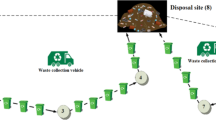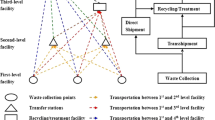Abstract
Integrated solid waste management (ISWM) comprises activities and processes to collect, transport, treat, recycle and dispose municipal solid wastes. This paper addresses the ISWM location-routing problem in which different types of municipal solid wastes are factored concurrently into an integrated system with all interrelated facilities. To support a cost-effective ISWM system, the number of locations of the system’s components (i.e. transfer stations; recycling, treatment and disposal centres) and truck routing within the system’s components need to be optimized. A mixed-integer linear programming (MILP) model is presented to minimise the total cost of the ISWM system including transportation costs and facility establishment costs. To tackle the non-deterministic polynomial-time hardness of the problem, a stepwise heuristic method is proposed within the frames of two meta-heuristic approaches: (i) variable neighbourhood search (VNS) and (ii) a hybrid VNS and simulated annealing algorithm (VNS + SA). A real-life case study from an existing ISWM system in Tehran, Iran is utilized to apply the proposed model and algorithms. Then the presented MILP model is implemented in CPLEX environment to evaluate the effectiveness of the proposed algorithms for multiple test problems in different scales. The results show that, while both proposed algorithms can effectively solve the problem within practical computing time, the proposed hybrid method efficiently has produced near-optimal solutions with gaps of < 4%, compared to the exact results. In comparison with the current cost of the existing ISWM system in the study area, the presented MILP model and proposed heuristic methods effectively reduce the total costs by 20–22%.










Similar content being viewed by others
References
Abbasi, B., Niaki, S. T. A., Khalife, M. A., & Faize, Y. (2011). A hybrid variable neighborhood search and simulated annealing algorithm to estimate the three parameters of the Weibull distribution. Expert Systems with Applications, 38, 700–708.
Abduli, M., Naghib, A., Yonesi, M., & Akbari, A. (2011). Life cycle assessment (LCA) of solid waste management strategies in Tehran: Landfill and composting plus landfill. Environmental Monitoring and Assessment, 178, 487–498.
Alumur, S., & Kara, B. Y. (2007). A new model for the hazardous waste location-routing problem. Computers & Operations Research, 34, 1406–1423.
Arena, U., & Di Gregorio, F. (2014). A waste management planning based on substance flow analysis. Resources, Conservation and Recycling, 85, 54–66.
Asefi, H., & Lim, S. (2017). A novel multi-dimensional modeling approach to integrated municipal solid waste management. Journal of Cleaner Production, 166, 1131–1143.
Asefi, H., Lim, S., & Maghrebi, M. (2015a). A mathematical model for the municipal solid waste location-routing problem with intermediate transfer stations. Australasian Journal of Information Systems, 19, S21–S35.
Asefi, H., Lim, S., & Maghrebi, M. (2015b) A proof-of-concept framework of municipal solid waste location routing problem. In Australasian transport research forum (ATRF), 37th, 2015, Sydney, New South Wales, Australia.
Asefi, H., Lim, S., & Maghrebi, M. (2017). Adaptation of simulated annealing to an integrated municipal solid waste location-routing problem. International Journal of Logistics Systems and Management, 28, 127–143.
Asgari, N., Rajabi, M., Jamshidi, M., Khatami, M., & Farahani, R. Z. (2016). A memetic algorithm for a multi-objective obnoxious waste location-routing problem: A case study. Annals of Operations Research, 250, 1–30.
Badran, M., & El-Haggar, S. (2006). Optimization of municipal solid waste management in Port Said-Egypt. Waste Management, 26, 534–545.
Behnamian, J., Zandieh, M., & Ghomi, S. F. (2009). Parallel-machine scheduling problems with sequence-dependent setup times using an ACO, SA and VNS hybrid algorithm. Expert Systems with Applications, 36, 9637–9644.
Bing, X., Bloemhof, J. M., Ramos, T. R. P., Barbosa-Povoa, A. P., Wong, C. Y., & Van Der Vorst, J. G. (2016). Research challenges in municipal solid waste logistics management. Waste Management, 48, 584–592.
Blazewicz, J., Pesch, E., Sterna, M., & Werner, F. (2005). Metaheuristics for late work minimization in two-machine flow shop with common due date. In Annual conference on artificial intelligence (pp. 222–234). Springer.
Boyer, O., Sai Hong, T., Pedram, A., Mohd Yusuff, R. B., & Zulkifli, N. (2013). A mathematical model for the industrial hazardous waste location-routing problem. Journal of Applied Mathematics. https://doi.org/10.1155/2013/435272.
Brito, S. S., Fonseca, G. H., Toffolo, T. A., Santos, H. G., & Souza, M. J. (2012). A SA-VNS approach for the high school timetabling problem. Electronic Notes in Discrete Mathematics, 39, 169–176.
Chang, Y., & Chang, N.-B. (1998). Optimization analysis for the development of short-team solid waste management strategies using presorting process prior to incinerators. Resources, Conservation and Recycling, 24, 7–32.
Cooper, L. (1964). Heuristic methods for location-allocation problems. Siam Review, 6, 37–53.
Dai, C., Li, Y., & Huang, G. (2011). A two-stage support-vector-regression optimization model for municipal solid waste management—A case study of Beijing, China. Journal of Environmental Management, 92, 3023–3037.
Dalfard, V. M., Kaveh, M., & Nosratian, N. E. (2013). Two meta-heuristic algorithms for two-echelon location-routing problem with vehicle fleet capacity and maximum route length constraints. Neural Computing and Applications, 23, 2341–2349.
Damghani, A. M., Savarypour, G., Zand, E., & Deihimfard, R. (2008). Municipal solid waste management in Tehran: Current practices, opportunities and challenges. Waste Management, 28, 929–934.
Edalatpour, M., Mirzapour Al-e-Hashem, S., Karimi, B., & Bahli, B. (2018). Investigation on a novel sustainable model for waste management in megacities: A case study in tehran municipality. Sustainable Cities and Society, 36, 286–301.
Eiselt, H. A. (2007). Locating landfills—Optimization vs. reality. European Journal of Operational Research, 179, 1040–1049.
EPA. (1996). Environmental guidelines: Solid waste landfills. Carlton, NSW: Environmental Protection Authority (EPA).
EPA. (2002a). Waste transfer stations: a manual for decision-making. Washington, DC: Environmental Protection Agency (EPA).
EPA. (2002b). What is integrated solid wate management? Solid waste and emergency response. Washington, DC: Environmental Protection Agency (EPA).
Erkut, E., Karagiannidis, A., Perkoulidis, G., & Tjandra, S. A. (2008). A multicriteria facility location model for municipal solid waste management in North Greece. European Journal of Operational Research, 187, 1402–1421.
Ghiani, G., Laganà, D., Manni, E., Musmanno, R., & Vigo, D. (2014). Operations research in solid waste management: A survey of strategic and tactical issues. Computers & Operations Research, 44, 22–32.
Habibi, F., Asadi, E., Sadjadi, S. J., & Barzinpour, F. (2017). A multi-objective robust optimization model for site-selection and capacity allocation of municipal solid waste facilities: A case study in Tehran. Journal of Cleaner Production, 166, 816–834.
Hansen, P., Mladenović, N., & Pérez, J. A. M. (2010). Variable neighbourhood search: Methods and applications. Annals of Operations Research, 175, 367–407.
Harijani, A. M., Mansour, S., Karimi, B., & Lee, C.-G. (2017). Multi-period sustainable and integrated recycling network for municipal solid waste—A case study in Tehran. Journal of Cleaner Production, 151, 96–108.
Herva, M., Neto, B., & Roca, E. (2014). Environmental assessment of the integrated municipal solid waste management system in Porto (Portugal). Journal of Cleaner Production, 70, 183–193.
Hosny, M., & Mumford, C. (2010). Solving the one-commodity pickup and delivery problem using an adaptive hybrid VNS/SA approach. In Parallel problem solving from nature, PPSN XI (pp. 189–198).
Jarboui, B., Derbel, H., Hanafi, S., & Mladenović, N. (2013). Variable neighborhood search for location routing. Computers & Operations Research, 40, 47–57.
Kirkpatrick, S. (1984). Optimization by simulated annealing: Quantitative studies. Journal of Statistical Physics, 34, 975–986.
Lin, C., Choy, K. L., Ho, G. T., Chung, S., & Lam, H. (2014). Survey of green vehicle routing problem: Past and future trends. Expert Systems with Applications, 41, 1118–1138.
Lin, C., & Kwok, R. (2006). Multi-objective metaheuristics for a location-routing problem with multiple use of vehicles on real data and simulated data. European Journal of Operational Research, 175, 1833–1849.
Lohri, C. R., Camenzind, E. J., & Zurbrügg, C. (2014). Financial sustainability in municipal solid waste management–Costs and revenues in Bahir Dar, Ethiopia. Waste Management, 34, 542–552.
Marshall, R. E., & Farahbakhsh, K. (2013). Systems approaches to integrated solid waste management in developing countries. Waste Management, 33, 988–1003.
Mcdougall, F. R., White, P. R., Franke, M., & Hindle, P. (2008). Integrated solid waste management: A life cycle inventory. Hoboken: Wiley.
Mladenović, N., & Hansen, P. (1997). Variable neighborhood search. Computers & Operations Research, 24, 1097–1100.
Mousavi, S. M., & Tavakkoli-Moghaddam, R. (2013). A hybrid simulated annealing algorithm for location and routing scheduling problems with cross-docking in the supply chain. Journal of Manufacturing Systems, 32, 335–347.
Narula, S. (1986). Minisum hierarchical location-allocation problems on a network: A survey. Annals of Operations Research, 6, 255–272.
Nema, A. K., & Gupta, S. (1999). Optimization of regional hazardous waste management systems: An improved formulation. Waste Management, 19, 441–451.
Nga, W. P., Varbanov, P. S., Klemešb, J. J., Hegyhátib, M., Bertókb, B., Hecklb, I., et al. (2013). Waste to energy for small cities: Economics versus carbon footprint. Chemical Engineering, 35, 889–894.
Rabbani, M., Heidari, R., Farrokhi-Asl, H., & Rahimi, N. (2018). Using metaheuristic algorithms to solve a multi-objective industrial hazardous waste location-routing problem considering incompatible waste types. Journal of Cleaner Production, 170, 227–241.
Samanlioglu, F. (2013). A multi-objective mathematical model for the industrial hazardous waste location-routing problem. European Journal of Operational Research, 226, 332–340.
Santibañez-Aguilar, J. E., Ponce-Ortega, J. M., González-Campos, J. B., Serna-González, M., & El-Halwagi, M. M. (2013). Optimal planning for the sustainable utilization of municipal solid waste. Waste Management, 33, 2607–2622.
Sbihi, A., & Eglese, R. W. (2010). Combinatorial optimization and green logistics. Annals of Operations Research, 175, 159–175.
Sharholy, M., Ahmad, K., Mahmood, G., & Trivedi, R. (2008). Municipal solid waste management in Indian cities—A review. Waste Management, 28, 459–467.
Sharif, N. S., Pishvaee, M. S., Aliahmadi, A., & Jabbarzadeh, A. (2018). A bi-level programming approach to joint network design and pricing problem in the municipal solid waste management system: A case study. Resources, Conservation and Recycling, 131, 17–40.
Shirazi, M. A., Samieifard, R., Abduli, M. A., & Omidvar, B. (2016). Mathematical modeling in municipal solid waste management: Case study of Tehran. Journal of Environmental Health Science and Engineering, 14, 8.
Slack, R., Gronow, J., & Voulvoulis, N. (2005). Household hazardous waste in municipal landfills: Contaminants in leachate. Science of the Total Environment, 337, 119–137.
Tan, S. T., Lee, C. T., Hashim, H., Ho, W. S., & Lim, J. S. (2014). Optimal process network for municipal solid waste management in Iskandar Malaysia. Journal of Cleaner Production, 71, 48–58.
TWMO. (2017). Tehran waste management organization [Online]. Tehran, Iran: Municipality of Tehran. Available: tehran.pasmand.ir.
Vincent, F. Y., Lin, S.-W., Lee, W., & Ting, C.-J. (2010). A simulated annealing heuristic for the capacitated location routing problem. Computer and Industrial Engineering, 58, 288–299.
Xi, B., Su, J., Huang, G. H., Qin, X.-S., Jiang, Y., Huo, S., et al. (2010). An integrated optimization approach and multi-criteria decision analysis for supporting the waste-management system of the City of Beijing, China. Engineering Applications of Artificial Intelligence, 23, 620–631.
Yadav, V., Karmakar, S., Dikshit, A., & Vanjari, S. (2016). A feasibility study for the locations of waste transfer stations in urban centers: A case study on the city of Nashik, India. Journal of Cleaner Production, 126, 191–205.
Yilmaz, O., Kara, B. Y., & Yetis, U. (2017). Hazardous waste management system design under population and environmental impact considerations. Journal of Environmental Management, 203(Part 2), 720–731.
Acknowledgements
The authors would like to thank Dr. Mohammad Vahab (The University of New South Wales), Dr. Ahmed Hammad (Curtin University), Dr. Masoumeh Khalajmasoumi (Applied Geological Research Center of Geological Survey of Iran), and Dr. Hossein Aghighi (Shahid Beheshti University) for their technical comments on methodology and supports for data processing; and Ms. Neda Danesh for her valuable efforts in proofreading the paper.
Author information
Authors and Affiliations
Corresponding author
Rights and permissions
About this article
Cite this article
Asefi, H., Lim, S., Maghrebi, M. et al. Mathematical modelling and heuristic approaches to the location-routing problem of a cost-effective integrated solid waste management. Ann Oper Res 273, 75–110 (2019). https://doi.org/10.1007/s10479-018-2912-1
Published:
Issue Date:
DOI: https://doi.org/10.1007/s10479-018-2912-1




